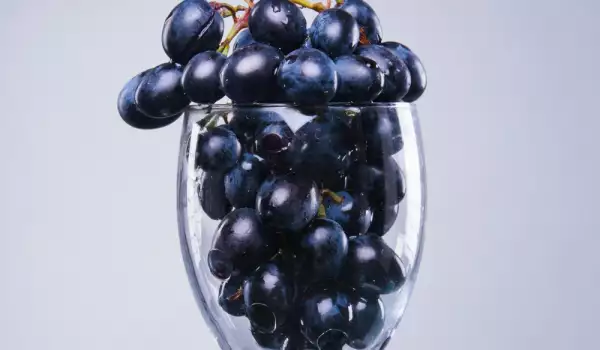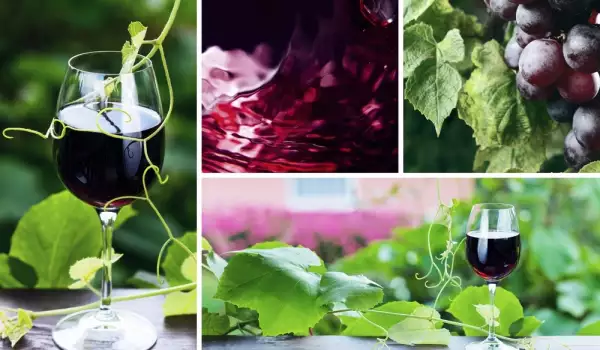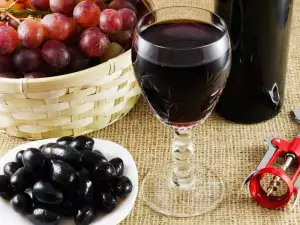Cinsault is a dessert grape variety used in winemaking. Its roots can be traced to France. Besides there it is widely grown in Russia and other wine producing countries.
Cinsault can be recognized by the following distinct characteristics: medium-sized, rounded leaves, colored green. They are pedate and covered in barely visible trichomes. The lamina in Cinsault is mesh-like and wrinkly. The leaf serrations are small, triangular. The stem is smooth, relatively long, light green colored. During fall, it is characteristic for the leaves of this variety to change their color to red.
Cinsault flowers are hermaphrodite. The grape cluster is medium-sized, cylindrical or conic. It is loose, semi-compact, with a medium long stem, woody near the branches. The grapes of this variety are large, egg-shaped, covered in a waxy coating. They are blue-red/black.
The flesh is juicy, slightly crunchy, with a nice, sweet, balanced taste. It leaves a particular aftertaste. The skin covering the flesh is thin, elastic. The fruits of these vines are used to produce red wines. The grapes are also suitable for direct consumption. If Cinsault vines thrive in a suitable soil, the resulting wine attains remarkable characteristics.
Cinsault is among the varieties that ripen normally. The harvest takes place during the first half of September. It thrives best in hilly terrains that possess light, fresh and warm soils. It tends to grow at a fast rate, with high fertility and a relatively large harvest.

Cinsault is preferred by winegrowers since it is resistant to drought. It is not affected by colder weather either. That leaves rot as its drawback, one thing it cannot save itself from. A rainy fall might be problematic for it, where it would be attacked not only by rot but by powdery mildew as well. It grows fine with other grape rootstocks.
History of Cinsault
As mentioned, Cinsault is native to France. It is believed that it is an ancient variety whose roots need to be sought out in the southern regions of the country. One possibility is for the variety to have been brought over by merchants from the eastern Mediterranean. But one thing is certain - Cinsault quickly managed to spread to many other areas as well. This grape is also grown in Algeria, where it thrives due to its ability to withstand the droughts.
These vines have even reached Australia, where the variety is called "Black Prince" and "Oeillade". The variety is also common in Italy, the US, Morocco, South Africa. In some of these countries it is mixed with other varieties to produce blended wines.
Characteristics of Cinsault
Wines produced from Cinsault are distinguished by a red color. Sometimes they can actually lean toward pink or orange. If the particular wine is of high quality it will possess a pleasant fragrance, with the texture practically caressing the palate. The beverage wafts a scent as sweet as the one felt while taking a sip. One can sense fresh fruity aromas, reminding of tiny fruits such as strawberries, raspberries and cherries.
Nuances of cocoa may also be felt. These types of grape elixirs are not particularly rich in tannins but even so their consumption is incredibly pleasant, especially if drunk along with suitable food. When taking a drink the 1st thing you'll notice is its velvety charm. A light, smooth and sweet Cinsault will enthrall you from the very 1st sip.
Serving Cinsault
Before serving, Cinsault needs to be cooled. A temperature around 60°F (16°C) is ideal. The wine needs to be poured out into suitable glasses. We advise you to go for the classic red wine glass. It is crafted from glass and possesses a fine, straight, cylindrical stem. The volume of this glass is not large but is enough to highlight the most remarkable qualities of the wine.

The classic red wine glass has a delicate form with very gradual, barely noticeable curves. It broadens in its lower part but begins to narrow near the stem and toward the rim. Thanks to it, one may experience the tannic notes and sour taste of the wine. The glass is perfect for all unpretentious red wines.
Cinsault can be combined with different foods. Dishes from bird meat such as turkey meat with pine nuts, skewers with turkey and ginger, chicken in green almond sauce, Bouchee a la Reine and duck magret are a fine choice. Of course you can always choose dishes made from more nutritious meats. The wine is a superb companion to dishes like veal steak with onion rings, veal skewers with peanut sauce and roast beef.
In case you prefer meatless dishes, you can combine the wine with various cheeses. Roquefort, Gorgonzola and Stilton come to the rescue. Fresh salads are also an excellent choice. If you make a salad with eggplants and cream, potato and dried pepper salad or Greek salad you'll differently enjoy the appetizing and harmonious results.








Comments